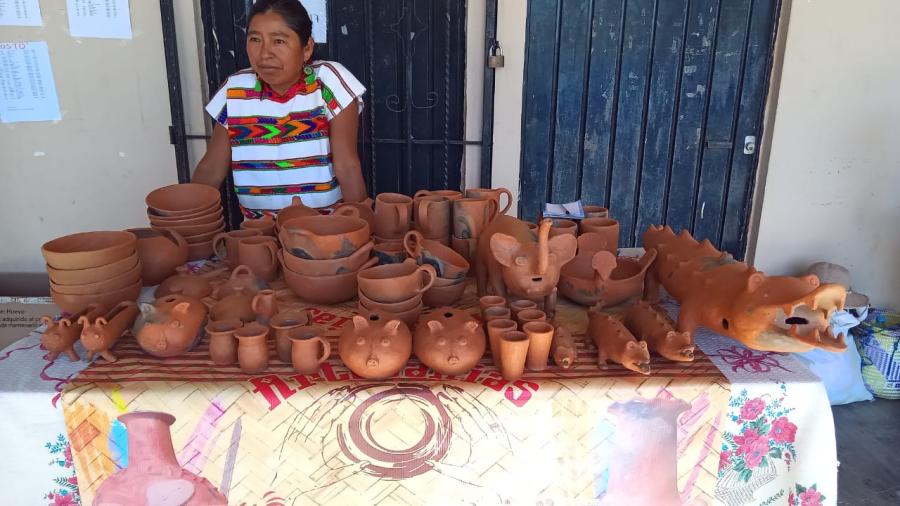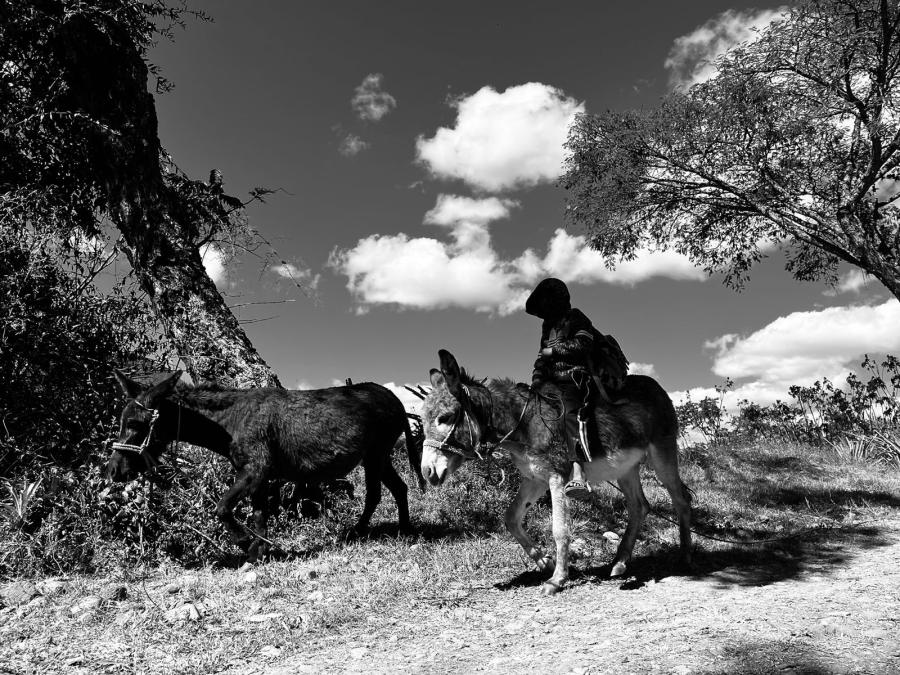"What does Doña Maria do," the anthropologist asked.
"She cooks, she makes tortillas. She goes to the fields, she goes to the mountain to get wood, she washes clothes. She raises chickens, she sews she sweeps the floor." On and on went Doña Alberta, Doña Maria's neighbor.
That was 1971. Nine years later, when I revisited San Cosme Mazatecocho in central Mexico, most women called themselves amas de la casa - housewives. Young women, who performed much of the domestic work, were said to be doing "nada" - nothing.
Until recently, women in all traditional societies combined diverse economic activities with their child-care responsibilities and domestic tasks. But the process called development frequently removes women like Doña Maria from their economic roles while simultaneously excluding them from a "modern" economy. All too often, a growing reliance on cash crops, wage labor, and commercial craft production - that is, the usual indicators of development - obscure, even eliminate, women as economic actors. It is the men of a community who seem to gain access to new technology, training, jobs, and credit and other resources.
When this narrow pattern of development persists, women either do withdraw or are seen - by themselves and others - as withdrawing from production and becoming financially dependent on husbands, sons, fathers, brothers. This discrimination feeds in part on official statistics, which may fail to acknowledge much of women's labor, whether in the subsistence sphere or in the informal sector, where participation is difficult to count.
Even though few women actually become full-time "housewives," women's subsistence production and kin-based exchanges come to represent a diminishing share of a family's consumption. This "domestication" or "housewifization" of women is a global phenomenon. In an environment that stresses income-producing over subsistence work, women's efforts are valued less, as when San Cosme women consider domestic labor nada.
Nevertheless, while planners and others may underestimate women's economic contributions, many women remain active on the local level. In such areas as animal husbandry, food processing, and trade, as well as in what Ester Boserup, author of Women's Role in Economic Development, calls "female farming," women in traditional societies are central to community economies. On the productive side, woman often continue to cultivate gardens and raise small animals, and they contribute to distribution as well. In Teotitl n, Mexico, for example, women control the exchange of good sand services through a system known as guelaguetza. Through the reciprocal relations of guelaguetza, women organize labor and obtain material resources to mount feasts for several hundred people. These feasts are still major political events that help establish the reputation of the husbands and sons who become the official leaders.
DIVERSE LIVES
As the articles in "Women's Work, Women's Worth" demonstrate, the relationship between gender, development, and tradition is complex. No direct line runs from traditional to modern society - whether that line would make women's work less important or more so. As feminist scholar Chandra Talpade Mohanty argues, there has been "a suppression... of the heterogeneity of the subject." It is a mistake to reduce women's diverse lives, for example, to a homogenous powerless group of "Third World women."
On the one hand, certain patterns clearly transcend-cultures. Thus, in some ways the experiences of those Third World women who have experienced "development" in past decades point to what will likely face indigenous women if their communities lose control over subsistence resources. When Afghan refugee women ask, "How can we be Koochi without our animals?" their question resonates thousands of miles away.
Yet an appreciation of crucial differences, of the diversity of all human experience, also applies to women's work and worth. Although the assembly plants of transnational corporation employ millions of Third World women, even in Mexico, where maquiladora factories have spread dramatically, they account for only one in ten industrial workers. Most women are not part of the global assembly line. According to Cornell University economist Lourdes Beneria, women comprise only about 3 percent of worldwide transnational employment. Except in Latin America, where service jobs dominate, and East Asia's newly industrialized countries like South Korea, most laboring women in developing countries remain in agriculture, where their tasks vary from paid labor to family farming to owning land.
Although some women are pushed out of agriculture by mechanization and the increasing concentration of land, others move out of more onerous agricultural activities but take on new assignments in the same sphere. In the 1970s, when wages were relatively high, the wives of San Cosme factory workers chose to stop working more distant fields in favor of raising chickens and pigs, running small stores, and tending gardens near their houses. In the Egyptian village of Tafahna al Ashraf, Lucie Saunders notes, women have shifted from agricultural labor to take part more in their own animal husbandry and dairy-processing enterprises.
Differences emerge as well in women's relations with one another. Some of these relations can entail conflict - such as those between servant and patrona or between farm worker and landowner. And conflict and cooperation can easily coexist, as in a family or household.
Age can be a further differentiating factor. According to Seung-kyung Kim's research, younger women perform most of the assembly-line work in Korea. Older women, however, must find other jobs, usually in the informal sector.
Important differences persist also in the nature and extent of inequality on the local level. In other words, Mohanty has pointed out, there is no singular experience of patriarchy. Even religious traditions that severely restrict women in some settings can, in other places, allow them some space to creatively negotiate. Diana Davis and Lucie Saunders reveal that such space exists in the two Muslim communities they discuss.
Even colonialism and development have multiple meanings and consequences. In every case, what women do and the valuation of women's work and worth depends largely on the details of the development process, as well as on an individual's class and on the cultural resources that members of particular communities have available.
WOMEN AND DEVELOPMENT
The failure to recognize diversity underlies the fact that development programs initially excluded women. Since the early 1970s, however, feminist scholars and activists have moved to question, and correct, the absence of women and their diverse experiences from development theory and practice. Their analysis, as well as their demands, have not gone unheeded. Recognizing that the benefits of "progress" at best bypassed women, many programs now direct at least some attention to integrating them into the development process.
The results have been mixed. When development projects are geared specifically to women or when the process opens up opportunities, some women gain. Additionally, as formal employment and wages of men fell through the 1980s, and as prices rose and government programs declined, women's earnings became more critical to support themselves, their families, and their communities. Economic crisis also raised the value of subsistence labor and informal-sector activities - realms women often dominate.
Women's gains, usually deriving from kin networks that provide access to labor, resources, jobs, and protection, suggest a starting place for effective development. Women's networks and women's proven ability to amass capital through them could be recognized as a powerful resource for change. Consider, for example, Panamanian migrants, who support one another in urban settings by providing job information, ensuring protection from abusive partners, and sending remittances to their rural families. And when patriarchal structures mean that kin resources, including the earnings of women, advance only the men in a family, women devise alternatives. Thus, Chamulan women build ties among co-workers and neighbors to defend themselves and secure job training and child care.
Unfortunately, because such ties are fundamentally local, development planners still often overlook them. Moreover, for reasons ranging from the global economic malaise in general to the ailing economies of developing countries in particular, the results even of many well-intentioned development projects have been limited. As the 1989 World survey on the Role of Women in Development notes, in most developing countries, "economic progress for women has virtually stopped, social progress has slowed, social well-being in many cases has deteriorated."
Most important, despite their diverse realities, women face a common obstacle: the power of local skin, work-place, and community networks to affect regional or international policy is minimal. As India's agricultural workers made clear when they told Joan Mencher to "Tell Them for Us," women's informal political power can't alter an underlying structure that is determined not by local practice alone put increasingly by global policies. Only when women, drawing on their diversity, make those policies will the underlying structure embrace the varying concerns, abilities, and sensibilities of women's lives and experiences, hopes and needs, work and worth.
Article copyright Cultural Survival, Inc.



